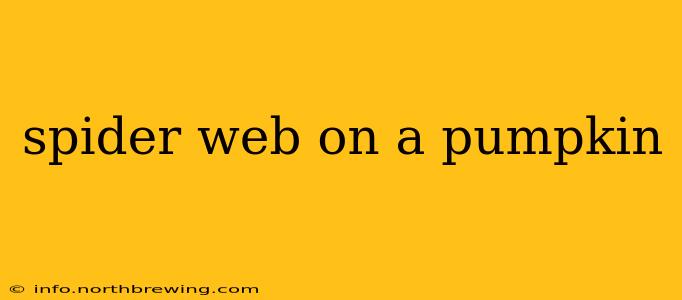Halloween is just around the corner, and what better way to celebrate than with a pumpkin adorned with a perfectly crafted spiderweb? This classic Halloween decoration is both eerie and enchanting, and achieving that perfect, spooky look isn't as difficult as you might think. This guide will walk you through creating a stunning spider web on a pumpkin, answering your burning questions and offering tips and tricks for a truly unforgettable Halloween display.
What are the best materials to use for a spiderweb on a pumpkin?
The beauty of a spiderweb on a pumpkin lies in its simplicity. You don't need expensive craft supplies to achieve a fantastic result. Here are some excellent options:
- White Craft Glue: This is a classic choice and provides a clean, crisp look. Allow plenty of time for drying.
- White Fabric Paint: This offers more durability and can be slightly more forgiving if you make a mistake.
- Hot Glue: For experienced crafters, hot glue allows for quick and precise web creation, but requires careful handling to avoid burns and mistakes. Use a low-temperature glue gun for better control.
- Yarn or String: For a more rustic or textured look, you can use white yarn or string. This method offers a more three-dimensional effect.
How do I make a realistic-looking spiderweb on a pumpkin?
Creating a realistic-looking spiderweb involves understanding the natural structure of a spiderweb. Start by lightly sketching the overall shape of the web with a pencil. Here's a step-by-step guide:
- Start with the center: Place a small amount of your chosen material (glue, paint, or a knot of yarn) in the center of your pumpkin.
- Create radiating lines: From the center, draw several straight lines outwards towards the edges of the pumpkin, mimicking the spokes of a wheel. These lines should be evenly spaced.
- Add the spiral: Starting from the outer edge of a spoke, create a spiral working your way inwards, crossing over the radiating lines. Don't worry about being perfectly precise; a slightly irregular web looks more natural.
- Add details: Once the basic spiral is complete, you can add smaller, more intricate details to enhance the realism. Consider adding thicker strands here and there or slightly uneven spacing in the spiral.
What are some creative variations for a spiderweb pumpkin?
Don't be afraid to experiment! Here are some creative variations to consider:
- Colored spiderwebs: Instead of white, try using black, purple, or orange paint for a unique twist.
- Glittery spiderwebs: Add some glitter to your glue or paint for a shimmering effect.
- 3D spiderwebs: Use yarn or string to create a more textured, three-dimensional web. You can even add small plastic spiders for extra spookiness.
- Combined designs: Incorporate other Halloween elements into your design, such as ghosts, bats, or other creepy crawlies.
Can I use a stencil for a spiderweb on a pumpkin?
While you can certainly use a stencil, it often restricts creativity. A freehand approach allows for more unique and organic-looking spiderwebs. However, if you prefer a more precise design, a stencil can be helpful, particularly for beginners. You can find printable spiderweb stencils online.
How do I get the spiderweb to stick to the pumpkin's surface?
The best method for adhesion depends on the material you are using. Craft glue and fabric paint will adhere well to the pumpkin's surface, but require drying time. Hot glue provides instant adhesion but requires precision and careful handling. For yarn or string, you might need a bit of glue to secure the starting and ending points.
How long does it take for the spiderweb to dry?
Drying time varies depending on the material used. Craft glue can take several hours, while fabric paint might require longer depending on the thickness of the application. Hot glue dries instantly but must be applied carefully.
By following these tips and tricks, you can create a stunning spiderweb pumpkin that will be the envy of your neighborhood. Remember, the key is to have fun and let your creativity shine! Happy haunting!
